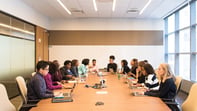Published on
From Fringe To Core: Agile Measures To Bridge The Gap

It doesn’t seem all that long ago when Peter Drucker, renowned management theorist and prolific writer, provocatively stated, “thirty years from now the big university campus will be a relic. Universities won’t survive in their present form.” In large part, this evolution emanates from the growing mandate to address the continuing education of an aging and diverse populace. A plethora of research exists that bears witness to this challenge before institutions of higher education and more specifically continuing education as a contributing stakeholder.
A new paradigm for higher education is coming into focus. It is elusive and has very little resemblance to the current brick-and-mortar hierarchies. It comes with a very distinct perspective and agenda that differs from the traditional tenets of higher education. In a time of dwindling budgets, global market expansion, and burgeoning minority population growth, continuing education providers stand to benefit from this emerging model in that we are well versed and experienced in drawing students from constantly shifting markets. We have operated on the fringes not necessarily by choice, but this has allowed us to innovate and integrate technological advances within regional and global markets. We have become the laboratory for ubiquitous learning that is no longer limited by time or distance. We are experts at finding the gaps in learning and filling them with timely, relevant, and results-oriented solutions that change lives.
At UT-Austin, Continuing and Innovative Education is setting the pace as a game changing architect of agile and innovative business models to serve new education markets both domestic and global. We are defining the new frontiers in what were once inaccessible markets. We benefit from our know-how in identifying trends and benchmarking for the successful execution of knowledge products and services.
Expanding our exploration of innovative models for research will allow us to be more responsive in an increasingly competitive borderless market and will provide the template for identifying best practices through comparative scanning. It will also lead to a transformative toolkit of integrative knowledge that can be disseminated to our campus colleagues for review, comparison, and inclusion in their best practices. Further, ongoing research will help us gauge the pulse of society, learn from our failures and communicate our takeaways via a network of knowledge partners to champion their cause as educators in a changing world.
Author Perspective: Administrator



